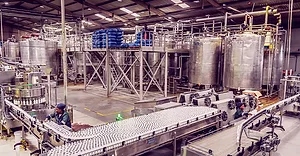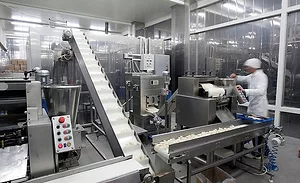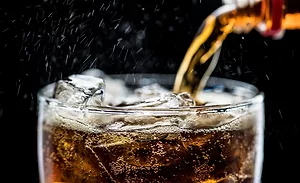Plant of the Year
Taking Old-World Processes Into the New World
April 11, 2024
Plant of the Year
Taking Old-World Processes Into the New World
April 11, 2024The JBS Principe facility, home of the company’s first foray into the Italian-style dried meat category, is FE’s 2024 Plant of the Year winner.
All images courtesy of Stellar
Sometimes an adventure starts with a goal in mind and sometime an adventure starts by simply putting one foot forward and seeing where it leads. For JBS, the adventure culminating in its Principe facility, FOOD ENGINEERING’s 2024 Plant of the Year, was a little bit of both.
Creating a facility that produced Italian dried meat products like pepperoni, salami and prosciutto was a clear goal. Another was to introduce a unique process for producing a boneless prosciutto that would reduce aging time, increase efficiency and output while maintaining the highest levels of food safety. The company set forth on its ambitions, tapping Jacksonville, Fla.-based AEC firm Stellar for the design-build project. It was afterward that JBS acquired Grupo King’s, which included the Principe brand of Italian meats.
“At the time the acquisition took place, construction of the Columbia facility was actually underway, so we were moving forward regardless,” says Joe Machetta, head of operations at JBS Prepared Foods. “The vision from the beginning was to create a tiered product approach and mimic what happens in Italy.”

JBS Foods Principe Facility
Owner: JBS Foods
Location: Columbia, MO
Size: 315,000 sq. ft.
Cost: $147 million
Site: 80 Acres, Greenfield
Construction Time: 24 months
Approach: Design-build
The Principe acquisition in 2022 gave JBS an established brand it could sell to while also giving the company an opportunity for some import business. Perhaps most importantly, it opened up the knowledge gained from years of experience producing Italian-style dried meats, which was added to the knowledge and experience already on the project.
“Stellar’s done several of these facilities over the years, so they brought a lot of knowledge of what they had seen and done elsewhere,” says Machetta, adding that staff at JBS also toured Italian facilities to be better informed.
“One of our strengths at JBS is on the raw material side,” says Machetta, “We had the expertise that could help us optimize that end. And we basically took all of this information and literally brought it into a room where we started to look at the process.”
One of the key aims was to introduce a unique process for producing JBS’ boneless prosciutto that would reduce aging time, increase efficiency and output, and maintain the highest quality standards. This process, which had previously only been used in Europe, was intended to be introduced to the U.S. through this facility.

Old-World Style Meets New-World Tech
As we all know, food across the world tastes different because of the raw material used, various spices and preparation. Columbia, Missouri was selected as the site based on factors such as access to raw materials, clients and transportation. But Missouri’s climate, with its extreme heat in the summer and extreme cold in the winter, is markedly different from Italy’s mostly Mediterranean climate. So, replicating environmental conditions from Italy in Columbia required a high-tech approach.
Looking for a reprint of this article?
From high-res PDFs to custom plaques, order your copy today!
Central to the operation, both literally and figuratively, are the drying rooms. Ironically, the central portion of the facility was finished later, following some of the peripheral areas as the project team took an “outside in” approach to construction. This was in response to challenges to enclose the facility at the start due to a shortage of certain materials. Thankfully, the problem was caught at the beginning of the project, allowing the team develop a plan and avoid major delays.

The team’s high-tech approach introduced a great deal of automation, such as sensors in the drying rooms to measure temperature, humidity and airflow, which is controlled by recipe-based programs to ensure the optimal conditions are maintained in the rooms no matter what the weather conditions are outside. The company was able to implement so many automated processes that products can practically go through the entire process without being touched by human hands.
“From the moment we receive raw meat—with the exception of prosciutto, which we are deboning, on the salami kitchen side—there is not a hand that touches anything until it comes out of the drying room and is peeled,” says Machetta. This was achieved through the introduction of automated guided vehicles (AGVs) to reduce human intervention, particularly in the thermal processes. The AGVs and their control systems can automatically track the weight of products throughout the process.
Raw food materials are received and manually inspected prior to being loaded into receptacles to be automatically blended, stuffed, formed and tied—the facility utilizes X-ray technology to analyze incoming raw material fat-to-lean ratios, allowing real-time adjustments to achieve specific SKU recipes. Products after stuffing automatically loaded onto sticks, and the sticks automatically loaded onto racks approximately 18-ft. high. The system can load numerous racks at a time, which eliminates the need for manually operated forklifts. Afterward, the AGVs take the meats to the appropriate room, either fermenting, salting or drying, to cure.
“To watch the product progress from the day it's put in there until the day comes out, with all the smells and the feel…it's just amazing,” says Machetta.

As much as the increased level of automation helps JBS compensate for a reduced labor force that has impacted the entire industry, it also helps prevent product contamination. To further improve food safety, the facility is divided into two separate sections, one for raw and one for ready-to-eat products. An environmental plan that meticulously maps all temperature and pressure zones, ensuring airtight segregation between raw and ready-to-eat areas, was created in order to minimize risk.
Before entering the ready-to-eat space, all products undergo stringent sanitation procedures. They are housed in atmospherically controlled “WIP” containers, ensuring optimal conditions before processing. Furthermore, the facility has installed vacuum pumps and water chillers in the interstitial space above the ceiling, enabling utility lines to be routed outside the ready-to-eat environment, thereby reducing potential contamination sources.
The slicing and packaging zones for ready-to-eat products are minimized and distinct, separated from exposed product areas, thus reducing sanitation requirements and minimizing contamination risks. Packaging machines are strategically partitioned by wall spaces, maintaining a clear separation between open product zones, finished sealed products and the packaging areas.
Seeing Where the Facility Leads
As much as JBS knew what it wanted in the facility, there were still some unknowns on the business side that meant the company had to leave some room for flexibility.
“On the secondary packaging side, we didn’t automate a lot and that was on purpose,” says Machetta. “We had a theory of what we were going to sell, but we didn’t really know what that looked like.”

The company took more of a speculative approach to certain elements of the facility, with the aim of configuring certain processes, such as the aforementioned secondary packaging, to suit customer needs as the business grew. As such, there’s currently room in the facility to add three more lines to the existing four without having to open the building up for expansion. Even when it comes time to expand beyond the existing walls, there won’t be a need to open up the facility until right before operations begin in those new areas because of the project team’s master plan.
The master plan includes a significant increase in fermenting and drying capacity, according to Stellar. The plan considers the expected future demand and provides enough infrastructure space to accommodate it. The mechanicals that run in the interstitial space above the ceiling but below the roof are capable of easily being extended to accommodate the new additions.

“On the far west side of the plant we built what we call the futures area,” says Machetta. “There’s nothing in the room, it’s just a mud bed on the floor covered in plastic that’s for future slicing or whatever we choose to do.
“So, we have that internal ability to grow now, but it wouldn’t be much if we wanted to knock out the wall and start taking up futures,” he adds.
Although the project began a few years ago, its journey, and JBS’, are just getting started. There’s an obvious vision as to what the project is expected to mean for the company in the end, as the high levels of automation and expansion capabilities make clear. But as most anyone who’s set out on an adventure into the unknown could tell you: the journey to get there is half the fun.







